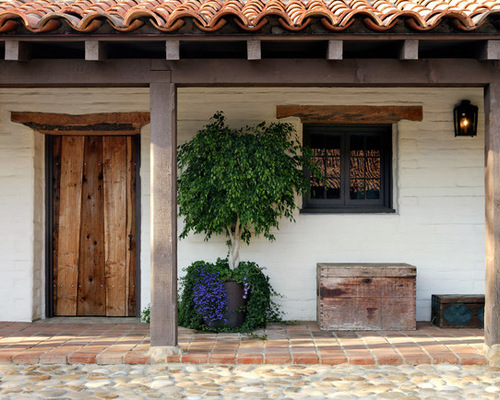There’s a reason that ficus, or weeping fig (Ficus benjamina) is one of the most common houseplants around. When it has settled into place, and you’ve figured out what it wants, it’s a fairly low-maintenance yet stunning houseplant. It’ll thrive for years, given the right conditions.
But what about ficus’ reputation for being fussy? That comes from its habit of dropping leaves. Leaf-dropping can occur just because the season has changed, but it can also be the result of stress on the plant from being moved, getting too much sun or water (if the leaves are still green) or getting too little water (if the leaves are yellow). Find it a happy spot that’s bright and away from drafts, where it can stay put, and it’ll usually settle back in.
Caution: Ficus can cause hay fever or asthma symptoms. Those with allergies to latex may react to the sap and leaves. Wear gloves when pruning.

Ficus 1: Kuth / Ranieri Architects, original photo on Houzz
Botanical name: Ficus benjamina
Common names: Ficus, weeping fig, Benjamin fig, Benjamin tree
Origin: India and Malaysia; has naturalized elsewhere
Where it will grow: Happy in any region as a houseplant; outdoors, hardy to 20 degrees Fahrenheit, or minus 6.7 Celsius (USDA zones 9 to 12)
Water requirement: Regular. Let the soil dry out slightly before watering; needs fast-draining soil that doesn’t become soggy.
Light requirement: Bright, indirect light, although it can handle some shade
Mature size: 1 foot to 10 feet tall indoors; in landscapes in tropical areas, such as Hawaii, it can reach 30 to 100 feet high and 50 feet wide

Ficus 2: Tom Meaney Architect AIA, original photo on Houzz
Benefits and tolerances: Adds height and presence to an indoor space; said to help remove formaldehyde from a home; easy to grow from cuttings
When to plant: Add to your houseplant collection anytime; plant in spring outdoors; take cuttings in early spring
Distinguishing traits. Ficus features thin, elongated leaves in shades ranging from bright to dark green; there are also variegated varieties. The trunks are light-colored and may be braided. The branches have a graceful, somewhat weeping appearance.

Ficus 3: Kristina Wolf Design, original photo on Houzz
How to use it. Use a ficus as a design focal point indoors. It’s especially effective when treated as a statement plant, but it can be used as part of a grouping of plants.
Stylish Plant Stands to Sit Your Ficus On
Outdoors, it’s ideal as a container plant for porches and decks that are out of direct sun — bring it indoors in winter if you’re not in a tropical or almost-tropical climate. In tropical areas, where it is very fast-growing and its aggressive roots can take over gardens, it can be trained as a hedge or screen.
Miniature ficus trees are an ideal bonsai choice for beginners.

Ficus 4: Liadesign, original photo on Houzz
Planting notes. Place your ficus in a bright spot away from drafts. Most important, once you’ve found a spot, avoid moving it if possible. To increase humidity levels, place a pebble tray under the planter.
Water when the top of the soil is dry from spring through fall, then cut back and water when the soil is dry at least an inch down in winter. Let the water run out the drainage holes. To help increase humidity levels, mist periodically.
Fertilize every three to four weeks with a balanced 20-20-20 water-soluble fertilizer at half strength. Ficus may be subject to light attacks of spider mites (remove with a spray of water), aphids, mealybugs and scale.
Tip:Ficus does not like to be moved, overwatered or in a drafty spot.

Ficus 5: Florida Nursery, Growers and Landscape Assoc, original photo on Houzz
Growing outdoors. If you live in a tropical or almost-tropical climate, you can also grow ficus outdoors. Allow plenty of room in the garden for its invasive roots.
Plant it in a spot with well-draining soil that is somewhat sheltered from wind. Ideally, your ficus would have six hours of sunlight a day, but it will be fine even in the shade. Provide about an inch of water each week in summer the first year you plant it. Water every couple of weeks, or when the soil is dry, after that.
Feed in spring with a controlled-release fertilizer with a slightly high nitrogen levels. Work the fertilizer into the soil around the tree, 6 inches out from the trunk, and water well. If you’re expecting frost, cover the plant with a light cloth, such as a sheet, taking care not to let the fabric touch the leaves. Remove any dead branches in early spring.
Stunning Houseplants for First-Timers

